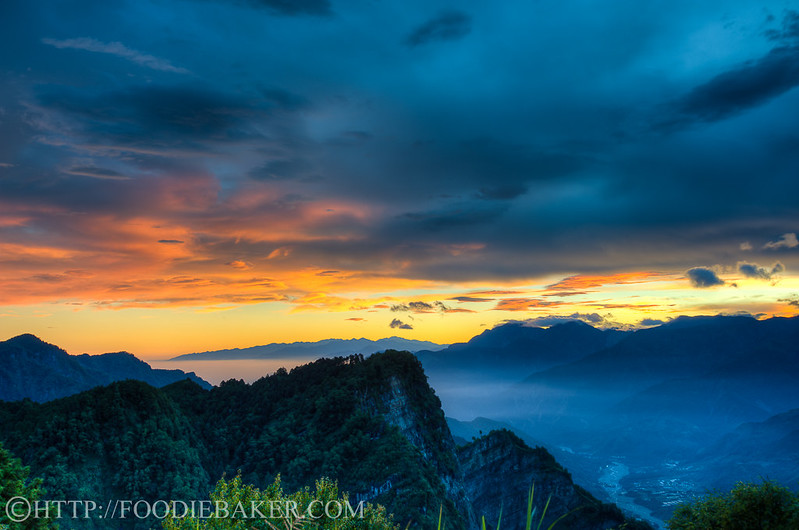
Sunrise at Alishan
If you are heading to Taiwan and is fond of greenery, nature and cool temperatures, Alishan National Scenic Park (阿里山國家風景區) will be one of the two places that I recommend you going (the other being Cing Jing, which I will blog about another time). The park is actually a mountain resort located in the mountains of Chiayi County in Taiwan.
The development of Alishan started during the World War II, when the Japanese built a narrow-gauge train to transport the giant cedar logs out from the forest area. After the end of the World War, the trees are still being transported using the train until late 1970s, when tourism had became the main source of income for the area. The train was then converted into a passenger train.
As we were heading to Alishan from Kaoshiung, we took a train from Kaohsiung (高雄火車站) to Chiayi (嘉義火車站) then we changed to a bus. At the bus station, there were a lot of taxi drivers asking us whether we want a ride up, but of course at a much steeper rate. As we weren’t rushing, we declined their “kind offers”. The bus ride took about 2.5 hours, and since we left early, we reached there just before lunch time.
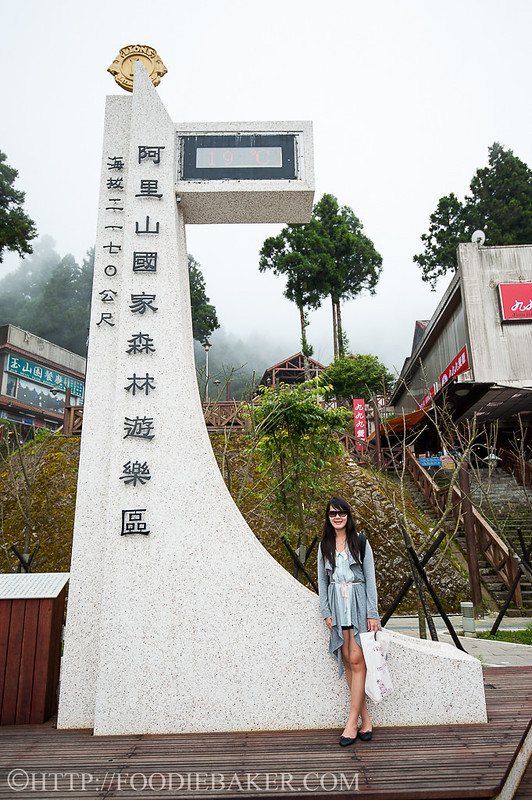
Clock Tower in Alishan
The clock tower shows not only the time, but also the temperature. As it was summer, the weather was pretty cooling, at about 19 degrees Celsius. As night, it can drop till 16 degrees Celsius. If you are visiting in the winter, it will be even colder! It was still alright to wear shorts in the day but I changed to pants after the sun sets.
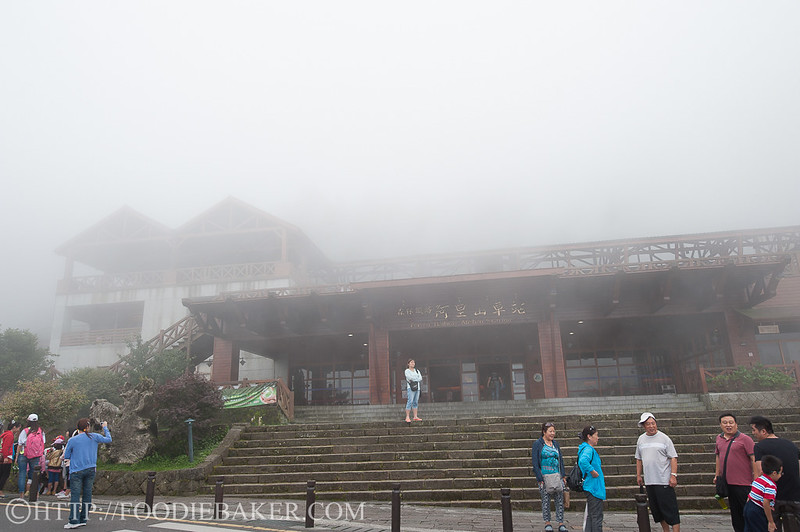
Alishan train station – shrouded by the mist
After putting down our bags and having a quick lunch (not fantastic so I’m not going to blog about it), we head to the train station to catch the train to the nature reserve.
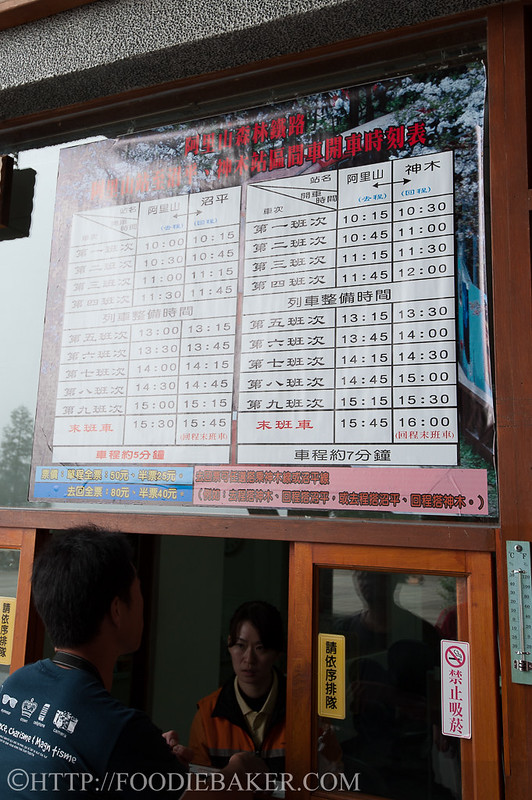 | 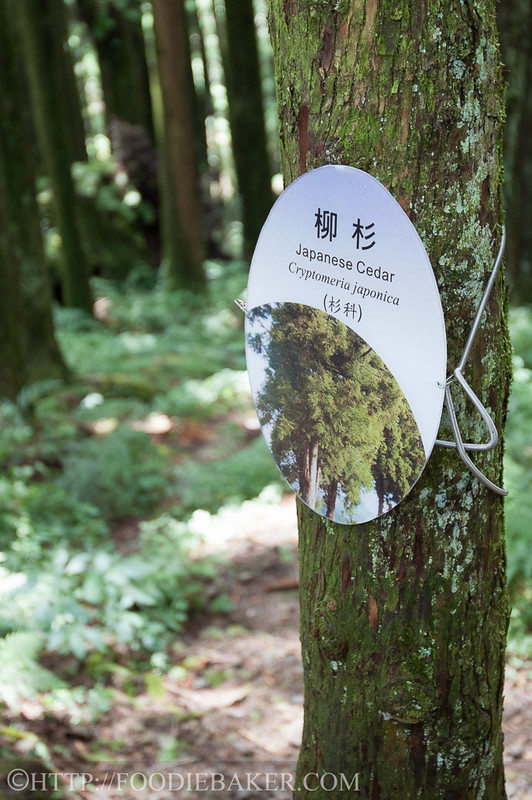 |
Train timings are listed at the ticket counter, including timings for the train to catch sunrise the next day. The sunrise train timing is not fixed so it’s best to note down the timing – there’s only 1 train there, so if you missed it, you’ll have to come back the next day. We also got the train tickets the day before so that we don’t have to waste time queuing to get it the next morning.
Japanese cedars are not related to the cedar family, but the cypress family. They are abundant in the forest and can reach up to 70 metres tall, with reddish-brown bark. There are other species of cypress trees in the forest, also with the unique reddish-brown bark. Because of this trait, tourists have been known to abused the trees by peeling off the bark and bringing it home as souvenirs. Hence, many old tree trunks are wrapped to prevent tourists from hurting the trees further.
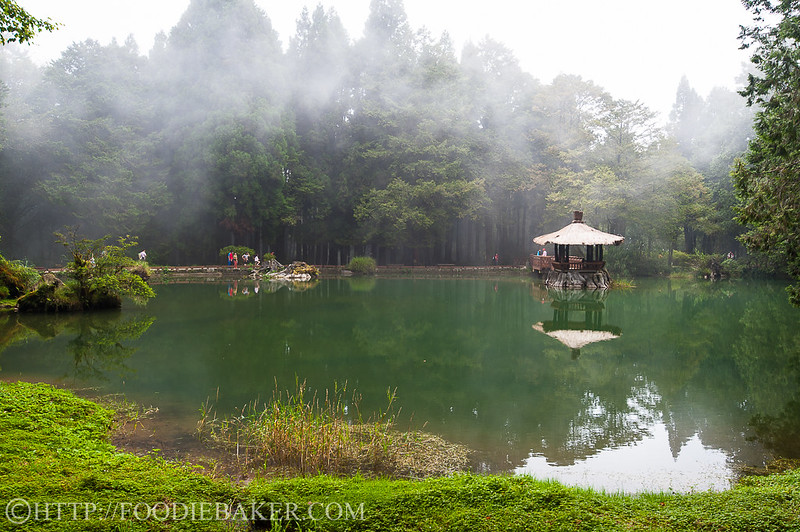
Sisters Ponds
Alishan was declared as a “national scenic area” only in 2001, so being relatively new, there are plenty of tourist groups flocking to this place every day. Not wanting to be a part of their rowdy group, upon alighting the train, X and I took our time to walk to the Sisters Ponds, and we also waited until the crowd had died down before X started taking photos.
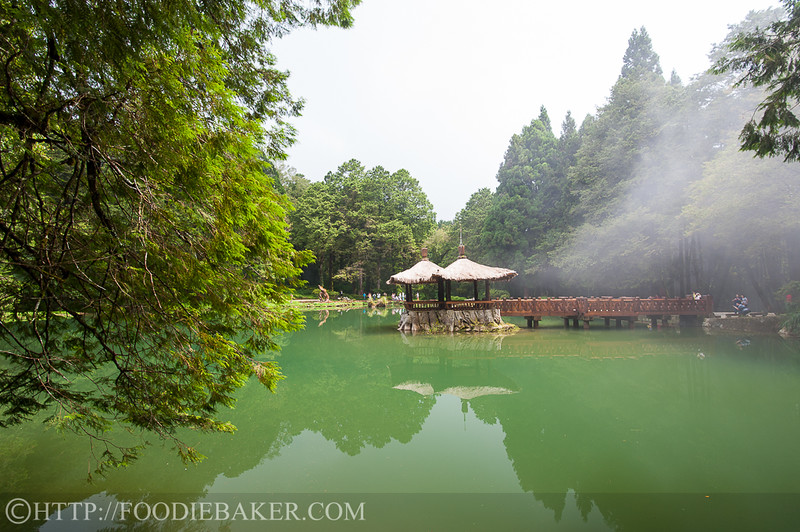
The Sisters Ponds are actually two high mountains ponds side by side above 2,100 meters sea level. The Elder Sister Pond is approximately 530 square meters while the Younger Sister Pond is approximately 66 square meters in terms of surface area. A gazebo made of cypress is built on the Elder Sister Pond.
I’m not sure how the name of the ponds come by, but it definitely would have been a very relaxing and peaceful place if not for the rowdy tourists and their tour guides explaining the sights using their portable microphones…
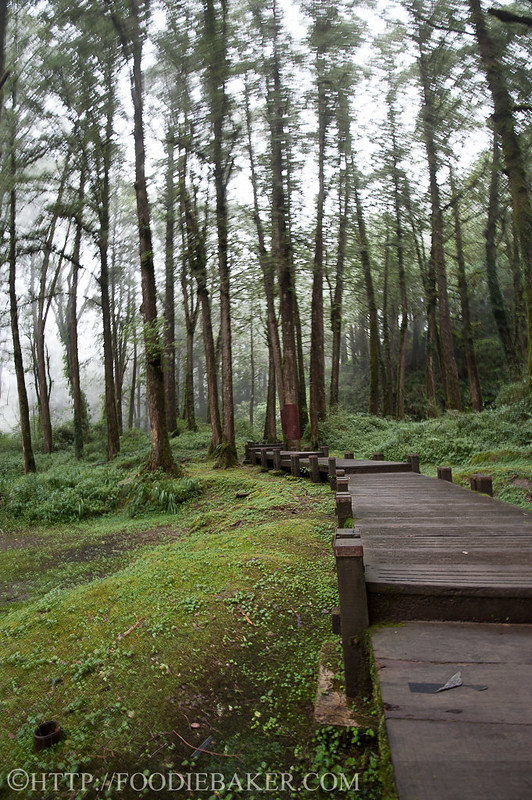 | 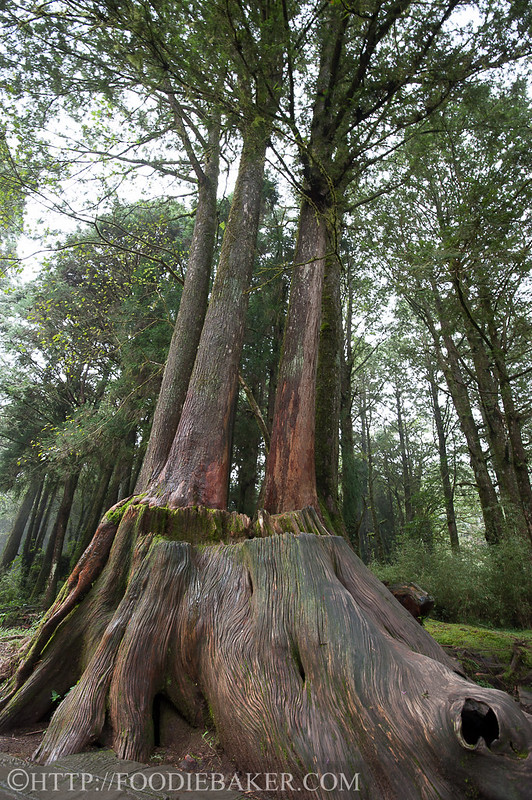 |
Left: bridge to another trail; Right: The Four Sisters
When an old cypress tree was felled, four cypress seeds happened to be dispersed into the cracks of the stump of the fallen tree, and they grew into trees side by side, giving it the name The Four Sisters.

Golden Pig Tree (金豬報喜) – can you spot the pig in the tree?
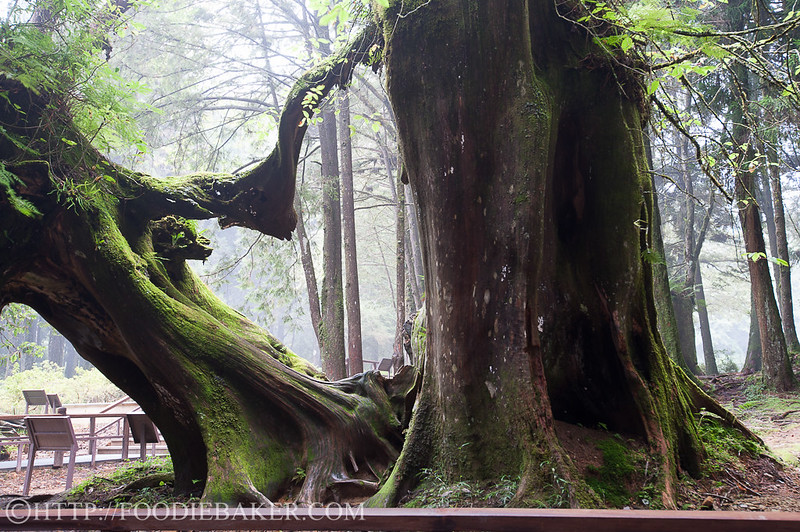
Forever One Heart (永結同心) – Grown from two old cypress trees
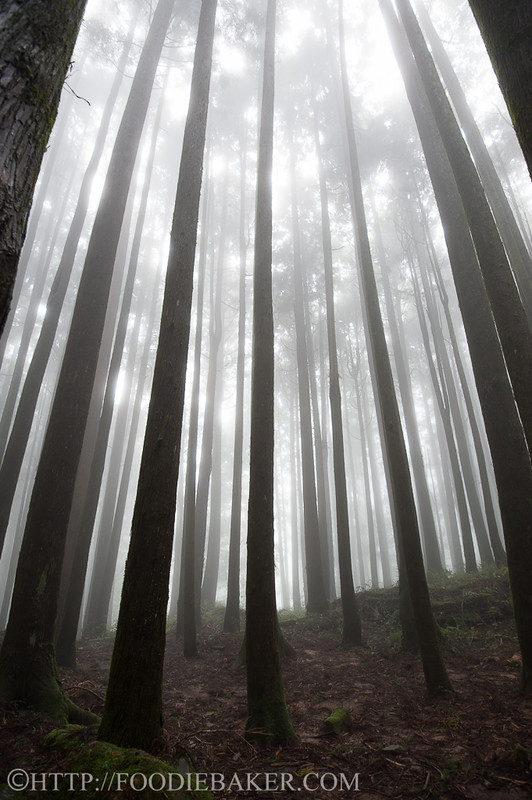 | 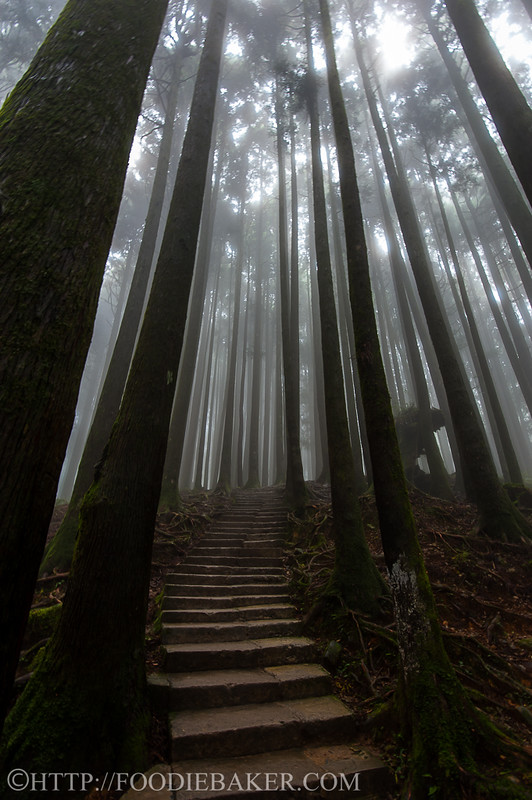 |
At the end of the Sisters Ponds trail, there is a flight of stairs down, with tall cypress planted on both sides. Very pretty and mysterious.
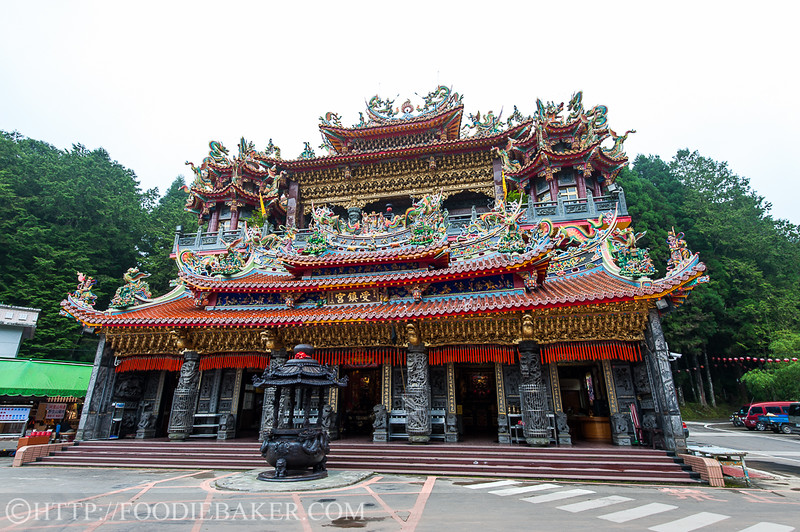
Alishan Shoujhen Temple (受鎮宮)
The Shoujhen Temple is the largest temple within Alishan area and situated 2,150m above sea level, it is also the highest altitude temple in Taiwan. I’ve read online that on every 3 March in the lunar calendar, just a week before Syuantian Emperor’s (God of Justice; 玄天上帝) birthday, a group of Alishan moths will appear and stay on the statues for without food and without moving for at least a week. The superstitious version is that the moths are there to celebrate the Syuantian Emperor’s birthday while the scientific version is that March and April are breeding seasons for the moths and they are attracted by the heavy smoke and lights emitting from the temple. Which one do you believe in?
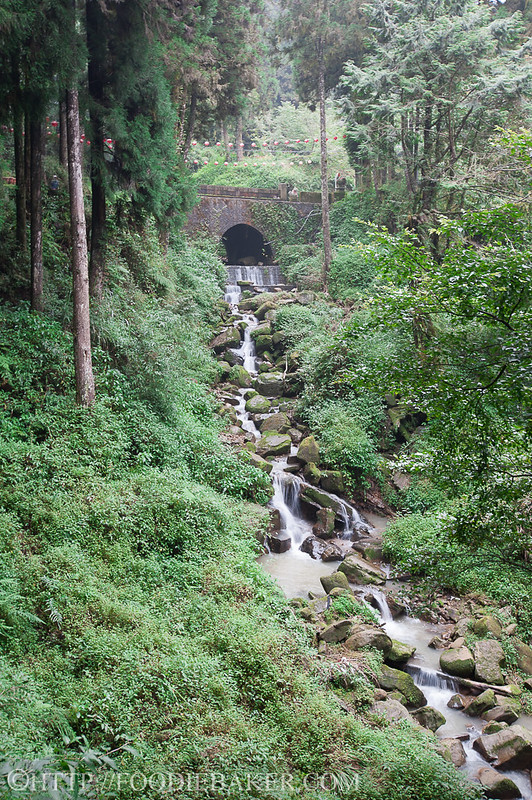 | 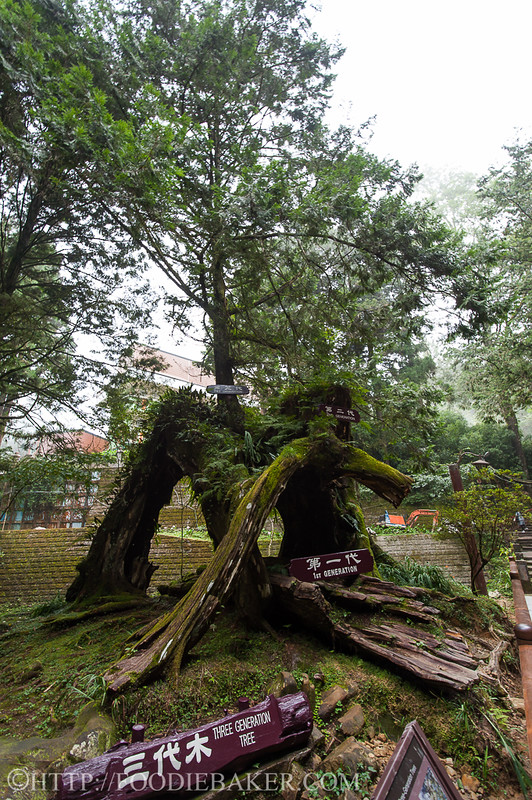 |
Left: A small stream; Right: Three Generation Tree (三代木)
We continued onto the Giant Trees Trail (阿里山巨木群棧道), and we passed by the Three Generation Tree – the first cypress tree grew for 1,500 years before it withered and died. After 250 years, the moss that grew all over provided moisture and with sufficient sunlight, a second cypress tree grew from the dead tree, sapping nutrients from the dead tree. After 300 years, the second tree died and many years later, a third tree managed to grow from it, hence giving it the name Three Generation Tree. This just shows how strong cypress trees can be!
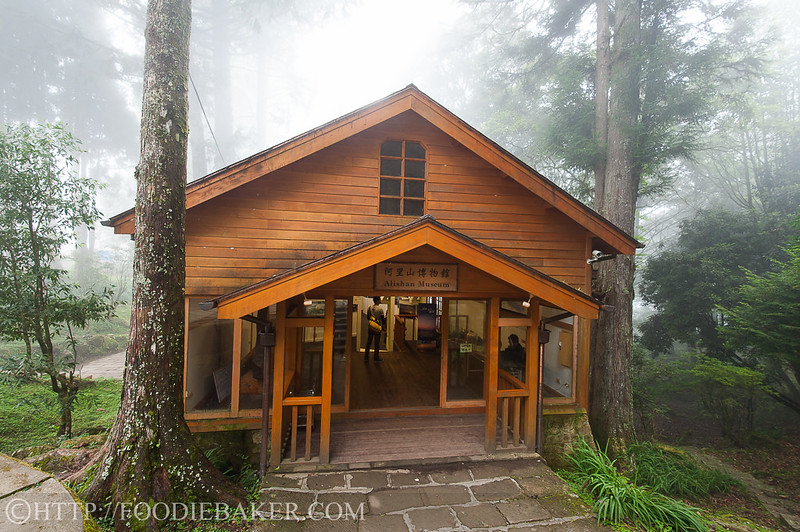
Alishan Museum
In the middle of nowhere (pretty much), there stood a wooden building (my guess is it’s built using cypress), which houses a photo exhibit of Alishan, the photos inside are really pretty!
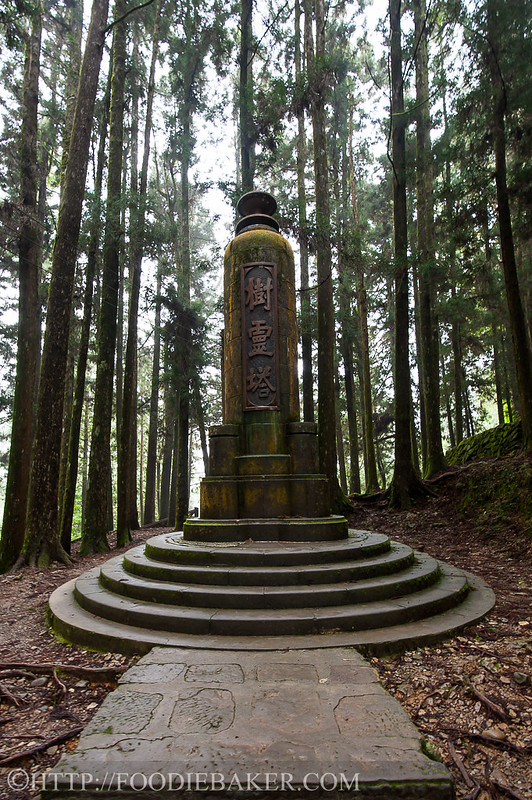 | 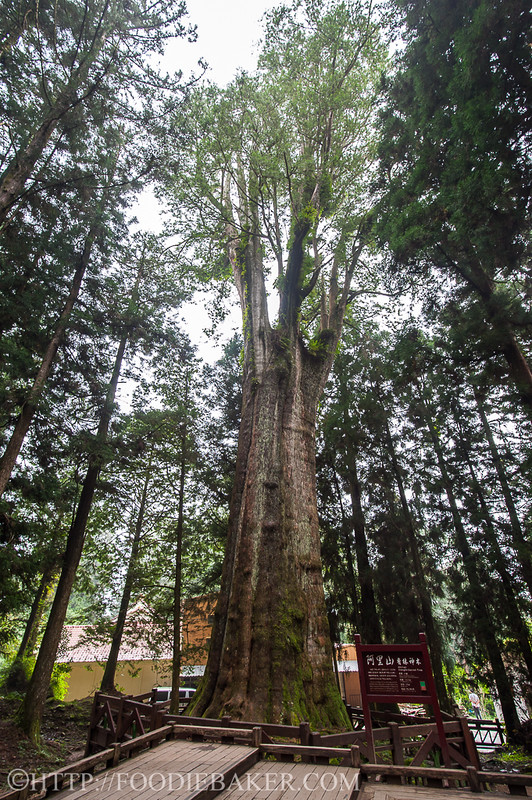 |
Left: Tree Spirit Pagoda (樹靈塔); Right: Xianglin Giant Tree (香林神木)
Not far from the museum stood a pagoda erected in 1936 during the Japanese colonial period. As the trees in Alishan were heavily logged during that period, a pagoda was built to pacify the tree spirits. The circular steps represents the growth rings of the tree while the pagoda itself represents the tree trunk.
Xianglin Giant Tree is… huge, majestic, and simply, WOW. Standing at at least 45 meters tall, this red cypress tree is about 2,300 years old! It is the second sacred tree in Alishan as the first tree died as it was struck by lightning.
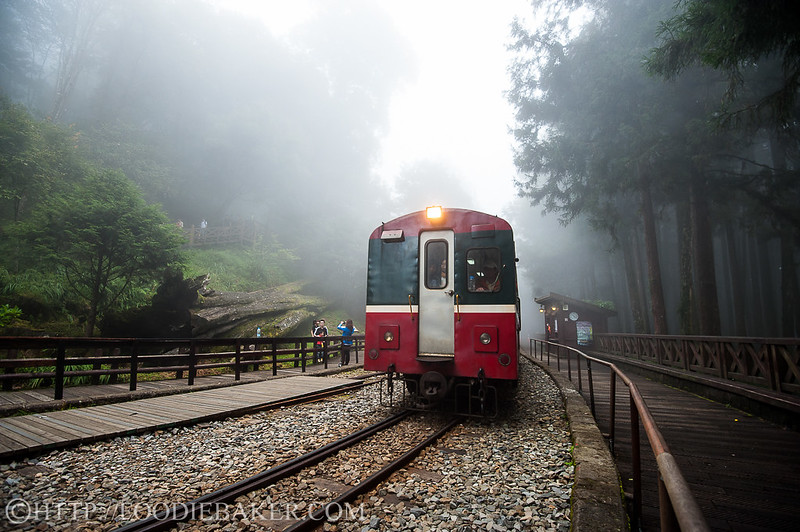
Alishan Shenmu Station (阿里山神木車站)
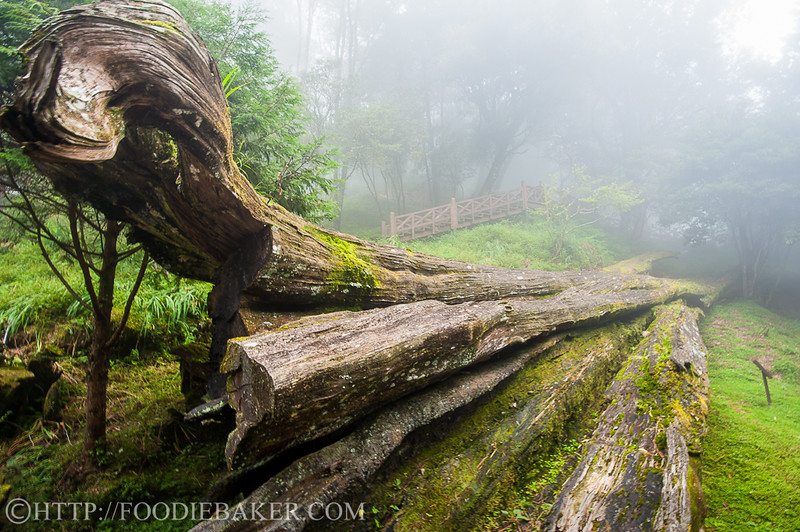
Alishan Sacred Tree (Alishan Shenmu; 阿里山神木)
Just next to the train station lies the very first sacred tree. This tree was discovered in 1906 by a Japanese technician. Standing at 55 meters and estimated to be more than 3,000 years old, it was being revered as the Sacred Tree. However, the earthquakes and typhoons in Taiwan did not bode well for the tree – the tree was struck by lightning twice – once in 1953 and once in 1956, with the latter causing the tree to burn inside out, resulting in the tree’s death. The earthquakes and typhoons also resulted in the soil around the tree to loosen, causing it to lean dangerously. In 1997, the torrential rain caused the soil to loosen and a part of the tree fell on the railway tracks. After reviewing the situation, the Alishan management decided to log the tree on 29 Jun 1998 and it was laid down at the place where it once stood, next to the train station.
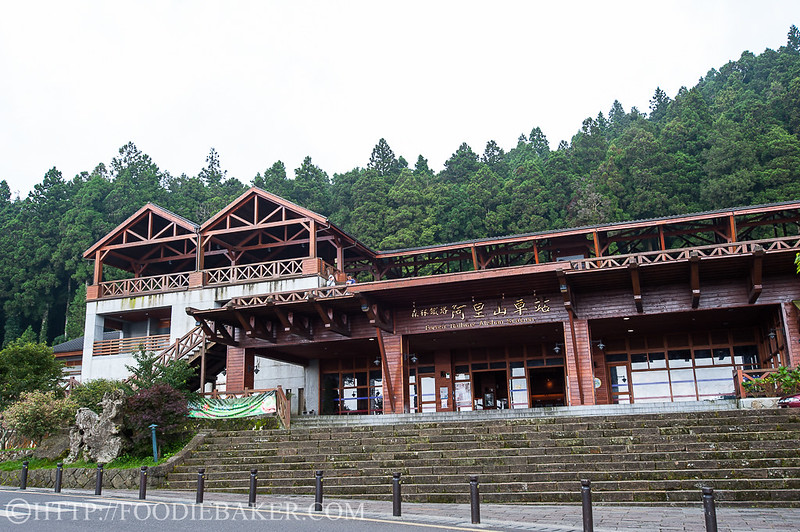
Another view of the train station – the mist had cleared!
 |  |
Left: Mochi snack before dinner; Right: Cold temperature at night!
Mochi is a pretty popular snack in Alishan, and I love those freshly made ones – pretty good!
 |  |
 |  |
Our dinner spread
I don’t think there’s much to do at night in Alishan, so we chose to have a long dinner at a nearby restaurant. We had steamboat (perfect in the cold weather) and also some of the common mountain dishes – stir-fried bamboo shoots and mushrooms, and stir-fried wild boar meat. If you’re on budget, there’s a 7-Eleven nearby and you can grab some cup noodles there.
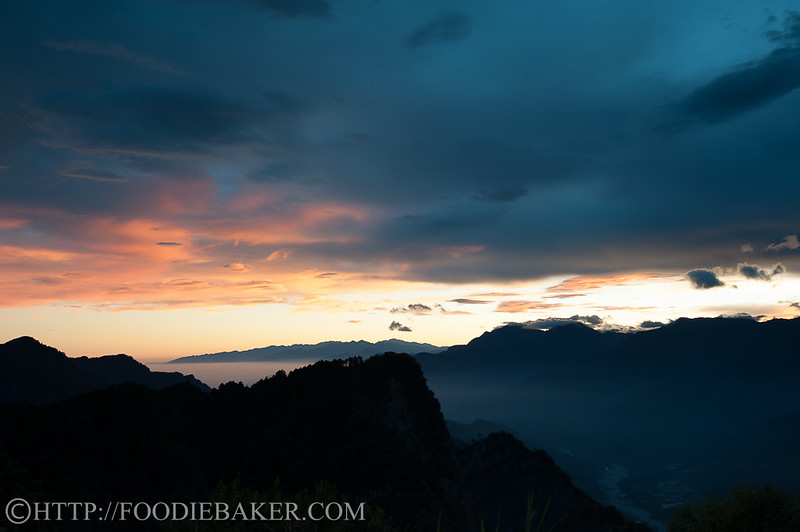
Sunrise at Alishan – see the sea of clouds (雲海)?
On the next morning, while holding a cup of hot coffee in our hands, we boarded the train to Jhushan (祝山), a 30-minute train ride from Alishan train station. When we alighted from the train, instead of crowding with the people on the viewing platform right next to the station, we walked for another 15 minutes to the helicopter pad. Unfortunately, the viewing platform next to the helicopter pad was closed as Typhoon Soala destroyed most of the path, making it too dangerous to head to the platform. Otherwise, the platform would have been a better place to view the sunrise as the crowd is thinner. Even so, there weren’t any people there except for us (and an uncle who was there exercising), so it was really quiet and peaceful.
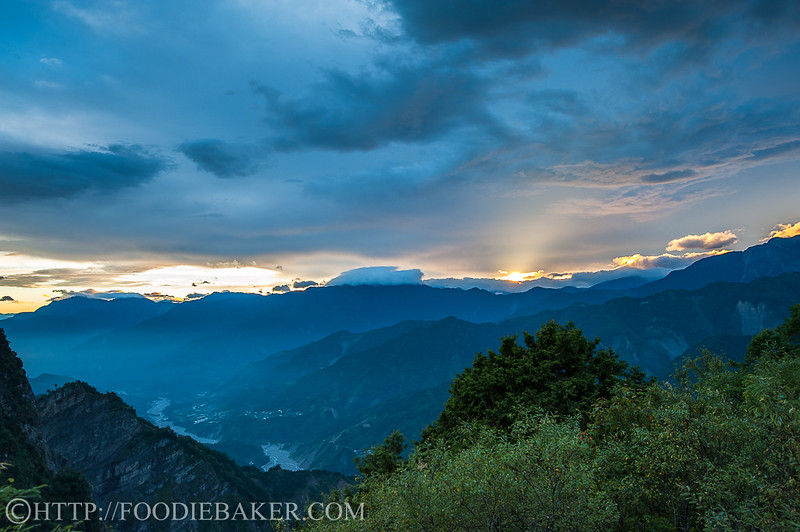
The sun peeking from the mountains
The sun was already up behind the mountains so the sky was pretty bright by the time we were there. The sea of clouds (雲海) wasn’t very dense as it was in the summer, but it was still a pretty amazing sight. The sea of clouds would be a lot denser in the winter, but it would definitely be a lot colder then!
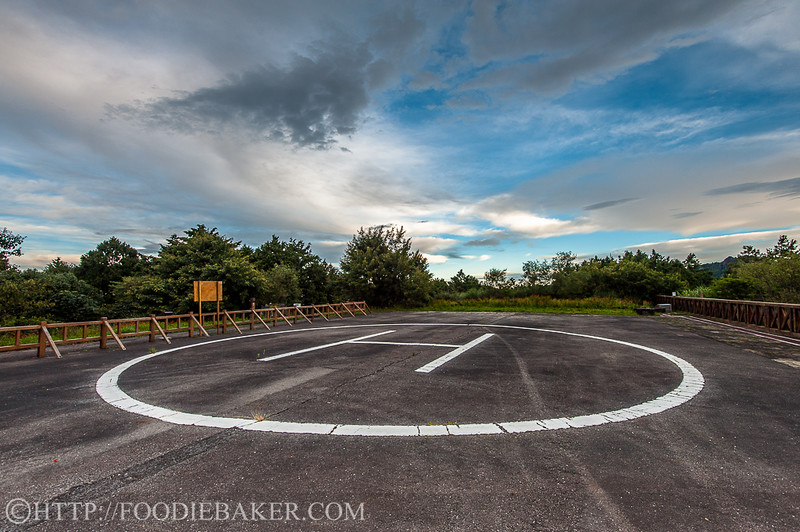
Helicopter pad where we viewed the sun rise from
If you have the time, it would be a great time to hike down – about 3-4km downhill hike. As we were catching a ride to Sun Moon Lake at 10am (and since we have already hiked the previous day), we caught the train (only 1 train back!) and went back for some snooze before hitting the roads again.
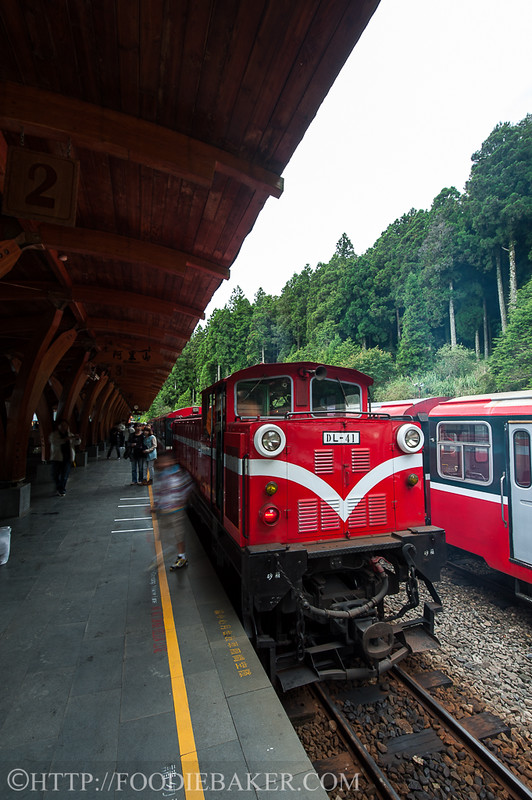 | 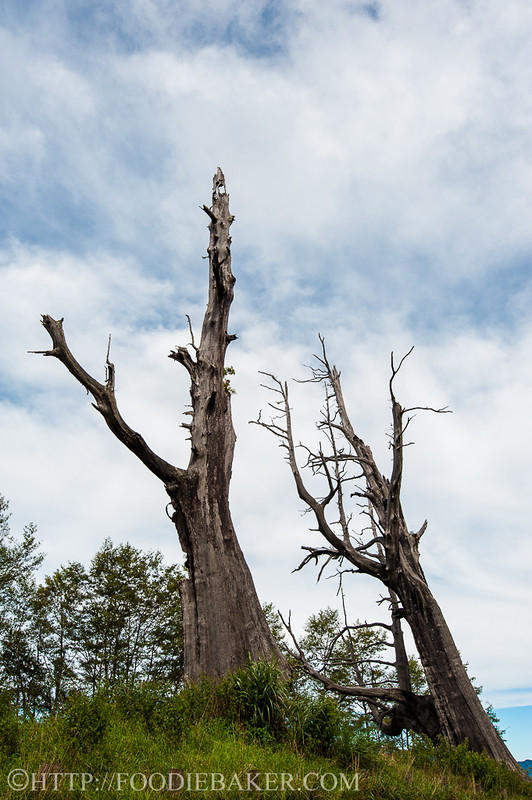 |
Left: Train at Alishan Train Station; Right: Husband and Wife Trees (夫妻树)
While on our way down the mountain, we passed by a pair of trees named Husband and Wife Trees (the one on the left is the Wife, in case you are wondering). This pair of dead red cypress trees were probably a couple thousand years old before they were burnt in 1963 and struck by lightning in 1996. Apparently it was also leaning dangerously (just like the First Sacred Tree), so the trees may be logged and laid down.
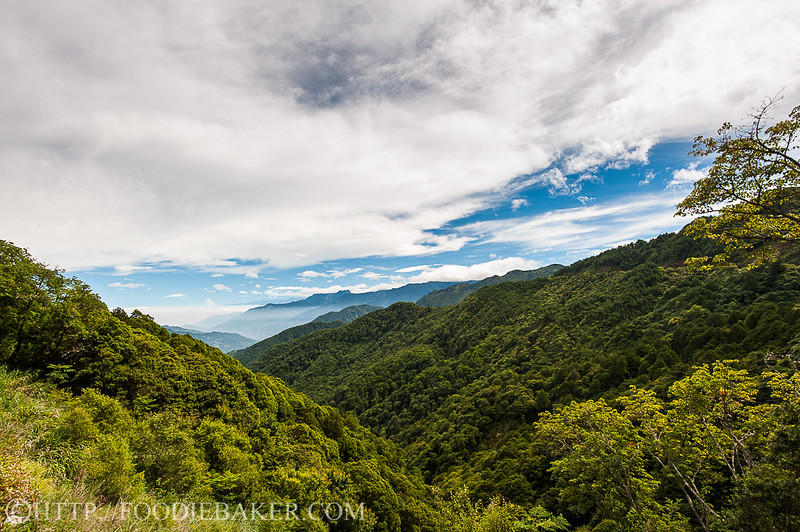
Can you see the sea of clouds in the far distant?
For the rest of the posts on Taiwan, see our Taiwan travel itinerary here!
Alishan National Scenic Park
(阿里山國家風景區)
| Getting there: | We took a bus from Chiayi (嘉義) at NT$221 (one-way). The ride is about 2 hours and the last bus to Alishan is at 2pm, while the last bus back to Chiayi is at 5.10pm (purchase the bus tickets at the 7-Eleven) – don’t listen to the taxi uncles or aunties telling you there is no bus up to Alishan – always check with the bus station operator when in doubt. If you want to take a taxi – be ready to pay NT$1,600 for the whole cab (maximum 4 people). There’s originally an Alishan Forest Railway from Chiayi all the way to Alishan, however, the railroads were damaged during the typhoon in 2009. It was announced that it’s unlikely to be opened |
| Getting around: | Take the Alishan Railway or simply walk your way around the place. Try to head back before night falls as there are no lights in the trail, you wouldn’t want to get lost there! Also advisable to stay one night so you can catch the sunrise! |
| Season to go: | Perfect all year round – there’s sakura blossom in the spring, a great hide-out from the summer heat during summer, and a dense sea of clouds to view in the winter. |
| To bring: | Besides necessities, do bring along extra warm clothing. It may get a little chilly in the morning when heading out to see sunrise. |
If you are planning a trip to Taiwan, you may want to check this out:

Get Your Grub On! says
hi there, we’ll be there tomorrow. may I ask which restaurant you ate, the dishes look delicious. Thanks for the nice blog.
Jasline N. says
Hello! I’m sorry I cannot remember exactly where we ate as we chose it randomly because the original restaurant we wanted to go to was closed! You may want to give 日出有大美 restaurant a try – read good reviews about it.
Get Your Grub On! says
Thanks so much I will check it out if I can. 😀
Michelle says
Hi, do you engage a driver to bring you around Alisan or you are on your own most of the time? Which minsu did you stay overnight?
Jasline N. says
Hi Michelle, we didn’t hire a driver to bring us around and we stayed at Shin Shin Homestay.
dru90 says
Hi. Can I know where you stayed in Alishan?
Jasline N. says
Hi Dru, we stayed at Shin Shin Homestay. (:
sandie says
Hi..I’ve plan’g to alishan this july. Could I have a trip in 1 day? From taichung early morning&go back to kaohsiung? Could I catch the last train alishan train to going back ? Are there rental locker for my luggage at alishan train station? Thank you..
Jasline N. says
Hi Sandie, I won’t recommend going there for only a day trip as you will miss the sunrise! I will suggest staying for at least one night (like what we did) so that you can wake up early the next day to catch the sunrise. It’s definitely something worth waking up early for. When we were there in 2011, there was no train servicing from Alishan to nearby cities/towns due to the damage caused by typhoon, so I’m not sure what is the new train schedule they have for now and whether they have rental lockers there, sorry I can’t help you on this!
Kim says
I love your Blog about Alishan. Me and my Fiance are planning our trip there two days from now and having pretty hard times. We just really want to see the sea of clouds and dont know where exactly we have to go to see them. I saw your picture but couldnt find a direction. Was that also at jhushan where you watched the sunrise? thanks so much
Jasline N. says
Hi Kim, thank you, glad you liked the post on Alishan. (:
Yes the sunrise is at Zhushan (Jhushan). Take the sunrise morning train at around 4.30am (you will need to queue early as there is only 1 train, and if you missed it, there is no other train available). The tickets can be purchased one day ahead (do confirm the train timing with the ticket counter as it varies with the season of the year). The train will bring you to Zhushan which there will be a platform to view the sunrise.
We turned left after reaching the platform and walked up the hill to a helipad. That’s where we watched our sunrise, minus all the tourists!
Hope you managed to catch an awesome sunrise and sea of clouds at Alishan! Our driver in Taiwan told us that winter is the best season to catch a thick layer of sea of clouds (;
une aiguille dans l potage says
Very nice picture ! Thanks for the lot of informations you give us on Alishan !
Carton King and Small Swiss Garden in Cingjing, Taiwan | Food Is My Life says
[…] Alishan, Taiwan […]
Sun Moon Lake, Taiwan (Part 2/2) | Food Is My Life says
[…] Alishan, Taiwan […]
girlinafoodfrenzy says
A beautiful country with such an amazing array of greenery, parks and culture. Not to mention the gorgeous variety of mochi pre dinner. I’m amazed by those lovely big trees and yes, the golden pig leaping through the tree stump too 😉 it certainly looks like a magical place and those lakes remind me of the great west lakes of Hungzhou in china a little.
elaine chan says
Wow, and double wow.. your photos are so mesmerizing! Seems a great place to visit!
Bam's Kitchen (@bamskitchen) says
Stunning photography. I am sure it is any day now you will be called by National geographic for an interview with these epic photos. I love the light coming through the trees, the mist coming from the mountains, you captured it all perfectly. So just out of curiosity, I know you take even more pictures than me, how many terabites of back up drives do you have to store all of your photos?
Choc Chip Uru says
Such a cultural and beautiful place my friend exemplified by your lovely photos 🙂
Cheers
Choc Chip Uru
ChgoJohn says
Such a wondrous post, Jasline! That opening photo of the sunrise is breathtaking. That must have been something to behold! I imagine walking through the cypress forest is much like walking through one of our redwood forests. It’s almost a spiritual experience, one hard to explain to those who’ve not done it. This is certainly a beautiful part of the World. Thank you very much for sharing your trip with us.
apuginthekitchen says
Breathtakingly beautiful the park and your photo’s the landscape is so lush. I would so love to visit.